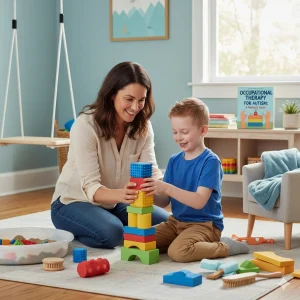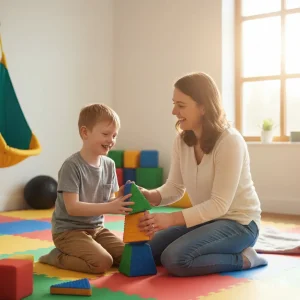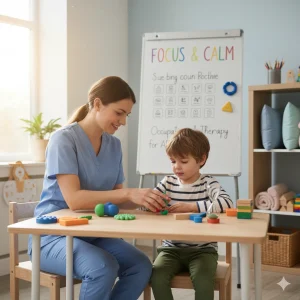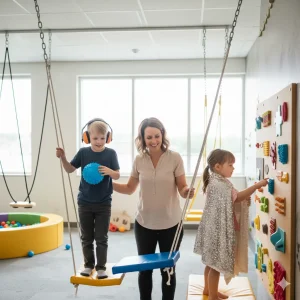Why Isn’t My 4-Year-Old Speaking in Full Sentences Yet?
Last Updated: August 7, 2025
“Why isn’t my 4-year-old speaking in full sentences yet?”
If you’ve been asking yourself this question, you’re not alone. Many parents notice their child saying a few words or short phrases but struggling to form complete, age-appropriate sentences. And that can be worrying — especially when other kids the same age seem to be chatting away with ease.
At age four, children are expected to hit important speech and language milestones — including the ability to use full sentences, express thoughts clearly, and engage in simple conversations. If your 4-year-old is not speaking in full sentences, it might be a sign of a speech delay, expressive language delay, or simply part of a wide range of normal development.
Free Speech Help for Kids
Concerned about speech delays? Book a free consultation with our expert speech therapist and get guidance tailored to your child’s needs.
What’s Typical Speech Development for a 4-Year-Old?
By age four, most children experience a big leap in their communication skills. This is when many parents begin noticing rich conversations, imaginative storytelling, and a growing vocabulary. But what exactly is normal speech development at age 4? What kind of sentences should a 4-year-old be saying? And how can you tell if your child is on track or falling behind?
Let’s explore what’s typical — and what might need a closer look.
Understanding Expressive and Receptive Language at Age 4
To better grasp speech development, it’s helpful to understand two key areas:
- Expressive Language: What your child can say — forming words, sentences, and thoughts out loud.
- Receptive Language: What your child can understand — following directions, recognizing meanings, and processing information.
At age 4, most children have developed strong receptive language skills and are rapidly expanding their expressive language abilities. This means they should be able to understand basic instructions and also communicate their own needs, thoughts, and feelings using fairly complete sentences.
What Do Full Sentences Look Like at This Age?
A 4-year-old child typically begins to form complete sentences that are 4 to 6 words long. These aren’t just two-word requests like “want juice” — they are more like:
- “I want to go outside.”
- “The dog is barking loudly.”
- “Can we play with blocks now?”
Children at this stage often start using:
- Pronouns (I, you, me)
- Plurals (cats, dogs)
- Verb tenses (jumped, running)
- Basic questions (Why? What’s that?)
- Connectors (and, because)
You may notice them narrating their play, asking lots of questions, or even retelling simple stories. These are signs of healthy speech milestones for 4-year-olds.
Is It Normal for a 4-Year-Old to Not Speak in Full Sentences?
As a parent, it can be heartbreaking to see your 4-year-old struggling to speak in full sentences — especially when you hear other children around the same age chatting confidently. So naturally, you may be wondering,
“Is it normal for a 4-year-old not to speak in full sentences?”
The short answer? Sometimes, yes — but not always.
Let’s break it down.
There’s a Wide Range of “Normal”
Just like walking or potty training, speech development varies widely from child to child. Some 4-year-olds may speak in long, complex sentences like mini-adults. Others might still be using short phrases or skipping parts of sentences altogether.
A 4-year-old might say:
- “Want go park.”
- “Me do it.”
- “That mine.”
While these aren’t complete sentences, they may still be part of normal development — especially if your child is progressing steadily in other areas and adding new words regularly.
When Delayed Speech Might Still Be “Normal”
There are a few common situations where kids may be perfectly healthy but just a little behind in sentence formation:
1. Bilingual Homes
Children exposed to two or more languages at home may take longer to form full sentences in either language. This doesn’t mean they’re delayed — just that their brains are working double-time to sort out vocabulary and grammar across two systems.
2. Quiet or Overshadowed Children
If your 4-year-old has older siblings who tend to speak for them, they may not feel the need to talk as much. Some kids are naturally shy or more reserved, which can delay how soon they use full sentences.
3. Late Bloomers
Some children are simply late talkers. As long as they show steady progress — even if slower than average — they may catch up on their own without needing therapy.
Reminder: Every child’s journey is different. What matters most is progress over time, not perfection at every stage.
When to Be Concerned: Red Flags to Watch For
While variation is normal, there are key signs that might indicate a speech or language delay — especially by age 4:
- Still speaking mostly in single words or two-word phrases
- Cannot form simple sentences like “I want water” or “Where is daddy?”
- Rarely asks or answers questions
- Difficulty being understood by people outside the family
- Limited vocabulary (less than 200–300 words)
- Frustration or tantrums related to communication
- Avoids speaking or stays mostly silent in social settings
If your child shows one or more of these signs, it’s a good idea to consult with a speech-language pathologist (SLP) for an evaluation. Early support can make a big difference.
Should a 4-Year-Old Be Talking in Sentences?
By this age, most children should be speaking in full, simple sentences. It doesn’t mean every sentence is perfect — but their communication should be growing more complex and conversational.
So while it can be normal for a 4-year-old not to speak in full sentences, especially in some situations, it’s important to trust your instincts. If something doesn’t feel right — it’s always okay to ask for help.
Common Causes of Speech Delay in 4-Year-Olds
If your child is 4 and still struggling to speak in full sentences, it’s natural to feel worried. While every child develops at their own pace, there are times when delayed speech in toddlers — especially by age four — may be a sign of an underlying issue.
Let’s explore the most common causes of speech delay in 4-year-olds, what they mean, and when to seek help.
1. Expressive vs Receptive Language Delay
One of the most common reasons for speech concerns is a language delay — but it’s important to understand what kind.
- Expressive Language Delay
This refers to difficulty putting thoughts into words. A child with expressive delay may understand everything you’re saying but can’t form clear sentences or struggle to find the right words.
Example: Your child might point to juice but say only “uh” or “want” instead of saying “I want juice.” - Receptive Language Delay
This means the child has trouble understanding spoken language. They may not follow directions or struggle to grasp what’s being asked.
Example: You say, “Bring me your shoes,” and they look confused or walk away.
Some children have both. That’s why a professional evaluation is important — it helps pinpoint exactly where the delay lies.
2. Hearing Issues
You can’t speak what you can’t hear clearly. Even mild or fluctuating hearing loss due to frequent ear infections can impact your child’s ability to learn and mimic speech sounds.
Watch for signs like:
- Not responding when called
- Needing high volumes for TV or devices
- Mispronouncing or omitting sounds
Hearing tests are painless and often the first step when evaluating late talkers.
3. Language or Speech Disorders
Some children may have a more specific speech or language disorder, such as:
- Apraxia of speech: A motor planning issue where the brain struggles to send the correct signals to the mouth.
- Phonological disorder: Difficulty understanding how sounds form words.
- Developmental language disorder (DLD): Difficulty using or understanding language with no clear cause.
These are more than just a delay and often require targeted speech-language therapy to improve over time.
4. Autism Spectrum Disorder (ASD)
One of the early signs of autism can be delayed speech or lack of meaningful sentence formation.
In addition to delayed or limited speech, children on the spectrum may:
- Avoid eye contact
- Show little interest in social interaction
- Repeat phrases (echolalia) without using them meaningfully
- Struggle with pretend play or imaginative language
It’s important to note: Not all late talkers have autism, but if these signs are present, a developmental screening is highly recommended.
5. Environmental and Social Factors
Sometimes the cause of delayed speech isn’t medical — it’s environmental.
- Excessive screen time: While cartoons and apps may seem educational, too much screen exposure (especially passive watching) can limit real-time interaction, which is key for language growth.
- Limited verbal interaction: Children learn speech through listening, imitating, and practicing. If they aren’t regularly engaged in back-and-forth conversation or play, their language development may slow down.
Also, in families with multiple children, the younger ones may not feel the need to speak as much if older siblings often talk for them.
Is Your Child Just a Late Talker?
Some kids are simply late talkers — meaning they’re slower to start speaking, but eventually catch up without needing long-term therapy. However, it can be hard to distinguish a true late talker from a child with a deeper issue without an expert evaluation.
Quick Tip: If your child understands you well, uses gestures, and seems eager to communicate — even with limited words — that’s a positive sign. But if you notice persistent difficulty expressing ideas or forming sentences, don’t hesitate to speak with a pediatrician or speech-language pathologist.
Signs of a Speech or Language Delay at Age 4
By the time your child turns four, you’re probably expecting to hear clear sentences, curious questions, and even little stories about their day. But what if your preschooler is still struggling to communicate — or only using a few words at a time?
It’s important to recognize the signs of speech delay in a 4-year-old, so you can take timely action and give your child the support they need to thrive.
Let’s look at what red flags to watch for — and what may signal a communication delay that goes beyond simply being a “late bloomer.”
What Speech Should Look Like at Age 4
Before we get into warning signs, here’s a quick snapshot of what typical speech and language looks like at this age:
- Uses 4–6 word sentences regularly
- Understands and follows 2–3 step directions
- Asks lots of “what,” “why,” and “where” questions
- Can retell simple stories or talk about past events
- Speech is 75%–90% understandable to unfamiliar adults
- Engages in back-and-forth conversation
If your child is missing many of these, it could be a sign of incomplete speech in preschoolers — and may need professional attention.
Red Flags: Signs of a Communication Delay at Age 4
Here are some common signs of speech or language delay in 4-year-olds that should prompt concern:
1. Still Using Mostly Gestures Instead of Word
If your child relies heavily on pointing, tugging, or facial expressions instead of spoken words, it might mean their expressive language isn’t developing properly.
Example: Instead of saying “I want water,” they may just point to the bottle or grunt.
2. Rarely Speaks in Full Sentences
While it’s okay for a few sentences to be short or choppy, consistent use of only 1–2 word phrases at age four may signal a problem.
Example: Saying only “want toy” instead of “I want that toy.”
This may also be paired with difficulty combining words or organizing thoughts clearly.
3. Not Asking or Answering Simple Questions
Children at this age are naturally curious. If your child isn’t asking questions like “Where’s mommy?” or “What’s that?” — or doesn’t respond when you ask them something simple — it may point to a communication delay.
Example: You ask, “What did you eat at school?” and they respond with silence or a single unrelated word.
4. Speech Is Difficult to Understand
While some pronunciation errors are normal at age 4, most strangers should understand what your child says at least 75% of the time. If your child’s speech is still very unclear or jumbled, it could be a sign of an articulation or phonological issue.
5. Limited Vocabulary for Age
By four, most children know hundreds of words. If your child only uses a small set of basic words — and struggles to learn new ones — it could reflect an underlying language delay.
6. Lack of Back-and-Forth Conversation
Even if your child speaks, are they engaging in dialogue? A child with a delay might talk in short phrases or give one-word answers, but won’t initiate or maintain a two-way exchange.
At-a-Glance: Missing Milestones Checklist
Here’s a quick checklist of potential signs your 4-year-old may have a speech or language delay:
- Doesn’t speak in full sentences regularly
- Uses gestures more than spoken words
- Speech is hard to understand by unfamiliar adults
- Doesn’t ask or answer simple questions
- Doesn’t engage in back-and-forth conversation
- Struggles to follow simple directions
- Has limited vocabulary for their age
If you’ve checked two or more of these, it’s worth reaching out to a pediatrician or speech-language pathologist (SLP) for guidance.
Remember:
Every child develops at their own pace — but if something feels off, trust your instincts. Identifying a speech delay early can help your child get the support they need before it impacts learning, confidence, or social development.
When Should You Be Concerned About Your Child’s Speech?
It’s completely normal for parents to wonder:
“When should I worry about my child’s speech?”
Or
“Is this just a phase, or something more?”
Children grow and learn at their own pace, especially when it comes to language. Some are quiet observers who suddenly start speaking in full sentences, while others are more vocal from the start. But by age four, certain speech and language milestones are expected — and when they’re missing, it may be time to stop waiting and start exploring support.
Knowing when to worry about speech delay can help you step in early and make a real difference.
Red Flags for Speech Delay in a 4-Year-Old
At age four, most children should be speaking clearly enough for unfamiliar adults to understand, using full sentences, asking and answering questions, and expressing thoughts and emotions.
Here are a few clear signs that something might be off:
- Rarely speaks in full, complete sentences
- Struggles to express needs or feelings with words
- Speech is still hard to understand by others outside the family
- Doesn’t ask “what,” “where,” or “why” questions
- Avoids talking in group settings or play
- Can’t follow 2-step instructions consistently
- Repeats words or phrases without context (echolalia)
- Frustration or tantrums linked to difficulty communicating
If your child is experiencing several of these signs past age four, it’s not just a phase — it’s a signal that an evaluation may help.
“Wait and See” vs. Getting an Evaluation
Many parents hear well-meaning advice like:
“Don’t worry, they’ll catch up.”
“My child didn’t talk until five!”
And while every child does develop at their own pace, the “wait and see” approach doesn’t work for everyone. In fact, waiting too long can delay the help your child needs.
So when should you stop waiting and take action?
- If your child is already 4 and not forming full sentences
- If your child’s speech hasn’t improved noticeably over 3–6 months
- If your gut is telling you something isn’t right
Then it’s time to consult your pediatrician or a speech-language pathologist (SLP). A simple speech evaluation can give you clarity — and if help is needed, early intervention is always more effective than late support.
Emotional Impact on the Child and the Parent
A child who struggles to speak may feel misunderstood, isolated, or frustrated — especially when they can’t explain how they feel or what they need. This can lead to:
- Increased tantrums
- Low confidence in social situations
- Withdrawing from play or group activities
- Falling behind in preschool or early learning
As a parent, you may feel helpless, worried, or even guilty — wondering if you’ve done something wrong. Please know this:
Speech delay is no one’s fault.
What matters most is how you respond once you notice the signs.
Getting help early not only improves speech — it can build your child’s confidence, ease your own anxiety, and bring back joy in communication for both of you.
Bottom Line: Trust Your Instincts
You don’t need to be an expert to notice that something feels off. If you’re asking,
“When should I worry about my child’s speech?”,
chances are — now is the right time to explore answers.
You know your child best. And if something doesn’t feel right, it’s okay (and encouraged!) to speak up, ask questions, and seek support.
When to Consider Speech Therapy for a 4-Year-Old
If your 4-year-old is struggling to form full sentences, frequently misunderstood by others, or showing signs of frustration when trying to speak — you might be wondering:
“Does my child need speech therapy?”
While every child develops differently, there comes a point when speech delays can start to impact your child’s learning, confidence, and relationships. That’s where speech therapy for toddlers — especially at age four — can make a huge difference.
What Can Speech Therapy Help With?
Speech therapy isn’t just about helping kids “talk better.” It’s a structured, personalized support system led by trained professionals who specialize in communication development. At age four, speech therapy can help with:
- Expanding vocabulary
- Forming clear and complete sentences
- Improving speech clarity and articulation
- Understanding and following directions
- Answering and asking questions
- Reducing frustration related to communication
- Strengthening early social conversation skills
Whether your child is barely talking or simply not progressing as expected, therapy can support both expressive (speaking) and receptive (understanding) language skills.
Speech therapy at this stage can be playful and fun — often using games, books, pictures, and interactive activities to help children learn and grow.
What Does a Speech-Language Pathologist (SLP) Do?
A speech-language pathologist — often called an SLP — is a certified expert in communication disorders. When you reach out for help, here’s what typically happens:
Step 1: Evaluation
The SLP will assess your child’s:
- Sentence structure
- Word use and grammar
- Understanding of language
- Speech clarity and sound production
- Social communication (eye contact, turn-taking)
This evaluation may include informal play-based tasks or standardized assessments — and it’s designed to be gentle, engaging, and child-friendly.
Step 2: Therapy Plan
If your child needs support, the SLP will design a therapy plan tailored to your child’s unique strengths and challenges. Sessions may be weekly and could involve:
- Modeling sentence-building techniques
- Practicing difficult sounds or words
- Strengthening listening and comprehension skills
- Teaching strategies you can use at home
You’ll also receive guidance as a parent — so you can reinforce what your child learns during daily routines and playtime.
Why Early Intervention Matters
You might wonder if it’s okay to wait a little longer. But in most cases, early intervention leads to better outcomes — both short-term and long-term.
Here’s why acting now is important:
- The brain is most adaptable between ages 0–5 — making it the perfect time to build strong language skills
- Children who get help early are more likely to catch up to their peers before starting formal school
- Speech delays can impact literacy, social-emotional growth, and classroom confidence if left untreated
- Addressing concerns early can reduce frustration and help children enjoy communication
“The earlier we can support a child’s speech and language needs, the easier it is to build strong, lasting communication skills,” says Anuradha Karanam, M.Sc., Speech-Language Pathologist.
A Gentle Reminder
Seeking speech therapy isn’t a sign of failure — it’s a sign of care. If your child is struggling to communicate clearly, even just a little, getting support from a speech-language pathologist can open doors to confidence, connection, and success.
How to Help Your 4-Year-Old Speak in Full Sentences at Home
If you’re wondering how to help a 4-year-old speak in full sentences, the good news is — you don’t need a classroom, flashcards, or fancy equipment. The most powerful tool for building your child’s language skills is you — and it all starts at home.
At this age, your child is absorbing language like a sponge. With the right support, they can move from one-word answers to full, confident conversations. Let’s explore some simple, everyday language development tips for preschoolers that really work.
1. Make Learning Fun with Play-Based Speech Activities
Play is a child’s language — so use it to your advantage. Everyday toys and games can become opportunities to build sentence skills.
Try these ideas:
- Pretend play with dolls, animals, or kitchen sets: Encourage storytelling — “What is the bear doing?”, “Let’s make the doll a sandwich.”
- Describe-and-find games: “Find something that is red and round.”
- Art and craft talk: Narrate what you’re making — “I’m cutting a circle,” and encourage them to describe their work.
- Car play: “The car is driving fast! Where is it going?”
The more back-and-forth conversation you have during play, the more your child learns sentence structure naturally.
2. Narrate Your Daily Routines
One of the simplest and most effective strategies is talking through your day — especially during routine activities.
- During meals: “I’m pouring the milk. You’re spreading the jam on toast.”
- During bath time: “First, we wash your arms, then your legs.”
- Getting dressed: “Let’s put on your red shirt. Where are your socks?”
This technique, often called self-talk or parallel talk, gives your child the sentence models they need — without pressure to respond. Over time, they begin to copy and build on what they hear.
3. Use Open-Ended Questions
Instead of questions that have just a “yes” or “no” answer, try ones that invite your child to think, describe, or explain.
Examples:
- “What did you do at school today?”
- “Why is the cat hiding?”
- “How can we build this tower taller?”
If your child gives a short or unclear response, gently expand on it:
Child: “Car go!”
You: “Yes! The car is going fast down the road!”
This simple trick teaches them how to form more complete sentences.
4. Limit Screen Time and Encourage Real Conversations
Screens are everywhere — and while some content is educational, nothing replaces real-life interaction. Too much passive screen time can reduce the amount your child hears and uses real language.
Instead of videos or apps that talk at your child, focus on:
- Storytime with real books
- Face-to-face conversations
- Singing nursery rhymes and songs together
- Asking them to help during chores — “Can you tell me what we need for dinner?”
Every interaction is a chance to practice language.
Know more: Understanding Virtual Autism: Impact of Screen Time
5. Use Speech-Friendly Apps and Tools (like the BASICS App)
Technology can still be a powerful support tool — when used the right way.
Look for apps designed by child development experts that:
- Encourage interaction (not just tapping)
- Use real-life visuals and modeling
- Support early sentence formation and vocabulary
Our Recommendation:
Try the BASICS App, a parent-friendly tool built to support speech and social development in toddlers and preschoolers. It’s packed with guided activities, short videos, and printable resources designed by speech-language pathologists — perfect for home practice!
“It’s like having a therapist in your pocket — helping parents know what to say, ask, and play to boost language every day.”
Final Tip: Be Patient, Be Playful, Be Present
Helping your 4-year-old speak in full sentences takes time, repetition, and lots of encouragement. Celebrate every effort — even the messy ones — and create a language-rich environment filled with curiosity, play, and connection.
You don’t need to be a speech therapist to make a big impact. You just need to be there, talk often, and make language a joyful part of your daily life.
Conclusion
If your 4-year-old is not speaking in full sentences, don’t panic — but don’t ignore it either. You’re not alone, and many children go through speech delays. Trust your gut. If something feels off, it’s okay to ask questions or get a speech evaluation. Early help leads to better results. With the right support, your child can catch up and learn to speak confidently. Whether it’s speech therapy or home activities, every small step matters. You’re doing great — and your child’s voice is worth supporting. Start early, stay positive, and keep encouraging their language every day.
Frequently Asked Questions:
1. Is it normal for a 4-year-old not to speak in full sentences?
By age 4, most children can speak in short but complete sentences — usually 4 to 6 words. It’s okay if some kids speak a little later, especially in bilingual homes. But if your child is still using mostly single words or short phrases like “want toy” instead of “I want that toy,” it could be a sign of speech delay. If you’re unsure, it’s always best to talk to a speech-language pathologist for guidance.
2. When should I worry about my 4-year-old’s speech?
You should be concerned if your child:
- Doesn’t use full sentences often
- Is hard to understand even by family
- Struggles to follow simple directions
- Doesn’t ask or answer simple questions
- Gets frustrated while trying to talk
These are signs that something might not be on track. If you’re wondering when to worry about speech delay, the answer is: trust your instincts and talk to a professional as early as possible.
3. What are the signs of speech delay in a 4-year-old?
Common signs of speech delay in a 4-year-old include:
- Not speaking in full sentences
- Using gestures more than words
- Limited vocabulary for their age
- Trouble asking or answering basic questions
- Speech that’s hard for others to understand
- Little interest in talking or playing with others
If your child shows several of these signs, it may be more than just “late talking.” A speech evaluation can help you know for sure.
4. What causes speech delay in toddlers and preschoolers?
There are many reasons why a child may have a communication delay, such as:
- Expressive language delay (trouble putting thoughts into words)
- Hearing problems, like frequent ear infections
- Autism spectrum disorder
- Developmental language disorder
- Too much screen time and not enough real conversation
- Limited social interaction, especially after the pandemic
Each child is different, so getting a proper evaluation is the best way to understand the cause.
5. Can a 4-year-old catch up with speech delay?
Yes — many children catch up with speech delay, especially if they get help early. With the right speech therapy and support at home, children can improve quickly. The earlier you start, the easier it is to close the gap. Don’t wait and hope it gets better on its own — early action leads to better results.
6. How can I help my 4-year-old speak in full sentences at home?
Here are some simple things you can do every day:
- Talk to your child during routines (bath time, meals, etc.)
- Use full sentences when you speak
- Ask open-ended questions like “What did you do today?”
- Play games that involve talking and storytelling
- Limit screen time and encourage face-to-face interaction
- Read books and let your child “tell” the story
These are great language development tips for preschoolers, and they make learning fun and natural.
7. Should I put my 4-year-old in speech therapy?
If your child struggles to form clear sentences, has limited vocabulary, or seems behind compared to other kids their age, then speech therapy for toddlers and preschoolers can be very helpful. A speech-language pathologist (SLP) can guide your child through fun, play-based sessions to build their skills. Getting started early can make a big difference before they begin school.
8. What does a speech therapist do with a 4-year-old?
A speech-language pathologist (SLP) works with your child to improve how they:
- Speak and form sentences
- Understand words and directions
- Use grammar and vocabulary
- Communicate clearly with others
Sessions often feel like play, using toys, books, and fun activities. The SLP also shows parents how to support their child’s progress at home.
9. Is too much screen time bad for speech development?
Yes. Too much screen time — especially passive watching — can limit your child’s opportunities to hear and use language in real conversation. Kids learn to talk by listening, copying, and interacting with people. Try to reduce screen time and replace it with activities that involve speaking, listening, and play.
10. Are there any apps or tools to support my child’s speech at home?
Yes, there are helpful tools designed by experts. For example, the BASICS App is created to support children with speech delay, autism, or learning differences. It includes:
- Short activity videos
- Printable resources
- Daily practice routines
- Parent-friendly guidance from speech therapists
Apps like this give you structured ways to support your child at home — anytime, anywhere.
About the Author:
Anuradha Karanam
Speech-language pathologist (7+ years of experience)
Anuradha Karanam is a skilled speech-language pathologist with over 6 years of experience. Fluent in Tamil, Telugu, Hindi, and English, she specializes in parent counseling, speech sound disorders, fluency assessment, and speech-language evaluations. Anuradha excels at working with children with developmental disorders, offering creative and effective therapy programs. Currently, at Wellness Hub, she holds a BASLP degree and is registered with the RCI (CRR No A85500). Her patience, ambition, and dedication make her a trusted expert in her field.
Book your Free Consultation Today
Parent/Caregiver Info:
Client’s Details:
* Error Message









